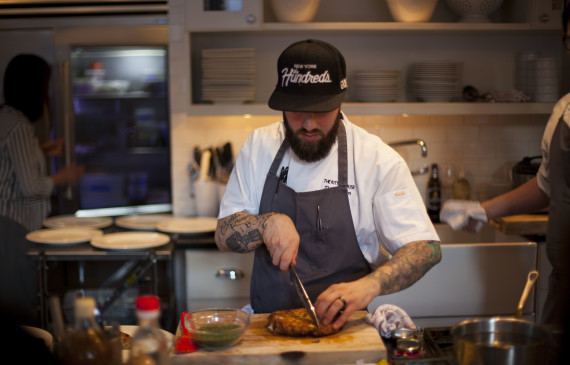Doug Allen, Chef De Cuisine at Lacroix, presented a Japanese feast for COOK guests while Kyoko Noguchi, General Manager at Serpico, provided the libations for not just a great evening, but also a celebratory Father’s Day. Doug’s menu was inspired by the food that Kyoko grew up eating, served to COOK guests with some modern touches. Read on to see what this husband and wife team served up, and learn more about Japanese cuisine.

While this may look like an hors d’oeuvre, this treat was in fact the cocktail that started off the evening. Kyoko created the Apple and Plum Sphere Cocktail by using a molecular process that we won’t delve into, but rest assured this sphere of spirits exploded with flavor, literally! When the sphere hits your tongue it disintegrates and the cocktail pops in your mouth. The apple and plum flavors were accented by the basil on the bottom of the spoon. A little nibble of the basil after consuming the sphere makes for a refreshing way to start off your meal. Kyoko also poured guests Denen Barley Shochu and Bride of the Fox Sake. While people may be familiar with the Japanese rice wine sake, its distant relative shochu is less familiar to the American palate. While both are clear spirits popular in Japan, the similarities between them end there. Sake is made from fermenting polished rice, while shochu is distilled often from barley. Sake’s alcohol by volume (ABV) percentage is slightly higher than wine. Shochu’s however, can range anywhere from 25 – 45%, which is why some refer to shochu as ‘vodka light.’ Shochu may be served chilled and neat, but an ice cube can temper its strength. Kampai!

Kyoko began class by saying that she could eat okonomiyaki everyday – it’s that good. Essentially a Japanese savory pancake or frittata, the name okonomiyaki derives from okonomi which means how you like and yaki which means grill. As the name suggests, you can add whatever you’d like to your savory pancake. Sticking with what they like making at home, Doug added duck and cabbage, a common ingredient in Hiroshima-style okonomiyaki. Doug said he won’t serve duck at Lacroix unless it has been aged for 10 days. After he cut the whole pan-fried duck okonomiyaki into wedges, Doug garnished them with Kewpie mayo (Doug swears it’s life-changing mayo), red pickled ginger, and katsuobushi, which is dried smoked tuna shaved into ribbon-like flakes.

Next up were the Izakaya favorites – popular Japanese bar foods. These are the dishes that Doug and Kyoko like to find when they eat out in Japan. A typical Izakaya experience is a group of friends or coworkers drinking plenty of beer and splitting small dishes that are typically quite salty, encouraging you to drink more. Doug made gyoza, Japanese pan fried dumplings accompanied by a dipping sauce that he admitted Kyoko is way better at making than him. This classic Japanese sauce consists of dashi (Japanese fish stock), mirin (rice wine similar to sake), fermented chili, toasted sesame oil, grilled scallions, and palm sugar.

The other main component to the Izakaya favorites course were robata skewers. Robata refers to a Japanese cooking method of grilling over hot charcoals. These skewers simply had a scallion in between two pieces of chicken thigh marinated in soy, sake, mirin and dashi. While working for Morimoto, Doug said that Chef Morimoto would joke that soy, sake and mirin were the Japanese Holy Trinity. After the scallion and chicken skewers were grilled, Doug added a little kimchi to the plate for additional spice. By the way, how adorable are those pineapple skewers!

Ochazuke is a dish in Japan typically served at the end of a long night of drinking and eating. Often it consists of leftover rice and fish and is served with a warm green tea or dashi broth. Essentially, you get a bit of caffeine from the tea and a bit of starch to absorb alcohol. Doug topped his ochazuke with madai, a Thai snapper, served raw. The Madai gets ever so slightly cooked by the tea, taking on a new taste and texture. Kyoko went around the room, pouring the green tea broth tableside into each guest’s ramekin, transforming the dish into the perfect way to cap off one incredible Japanese meal.
Back to Blog



